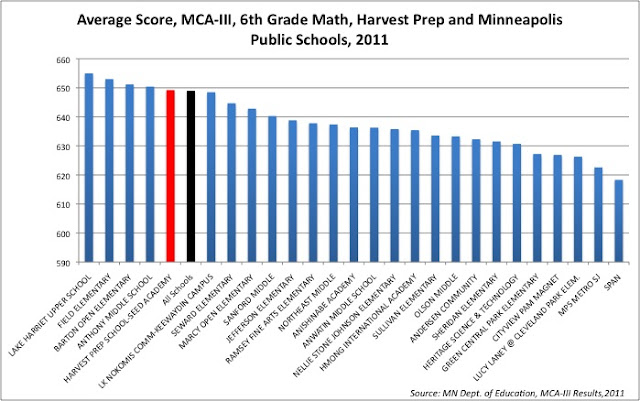Last week, The Economist decided it wanted to try to do charters, giving us yet another opportunity to see how the press so often gets education wrong. As is apparently taught at all journalism schools, the story starts with an example of chartery success:
“EVERYONE’S pencil should be on the apple in the tally-mark chart!” shouts a teacher to a class of pupils at Harvest Preparatory School in Minneapolis. Papers and feet are shuffled; a test is coming. Each class is examined every six or seven weeks. The teachers are monitored too. As a result, Harvest Prep outperformed every city school district in Minnesota in maths last year. It is also a “charter” school; and all the children are black.Notice the careful phrasing: Harvest Prep didn't beat every city school; it beat every city school district. See, charters are their own districts, which means that little Harvest Prep, with its enrollment of 343 kids, is going up against Minneapolis, which enrolls over 36,000 students. That hardly seems to be an apt comparison.
So how does Harvest do matched up with urban schools? Well, maybe not at the top, but actually very well:
(Sorry, "All schools" means "all Minnesota schools." Hey, what do you want for free?)
OK, so Harvest hasn't outperformed every school in Minneapolis (and I'm not even including the other charter schools - sorry, way more data massaging than I'm willing to do!). But let's be honest - this is really quite good. They even beat (barely) the state average.
And, yes, this is a school where nearly 100% of the children are black:
This is from the National Center for Education Statistics, so a source with very slightly different data (and a year older). You can see that the numbers confirm this is a school that has a student body that is almost entirely African-America. No surprise: the school's website describes it as "...the only accredited full-time, African-centered pre-school and elementary school in the state of Minnesota." Whatever you may think about that as a matter of principle, there is no doubt Harvest has a student body that is composed entirely of minority children.
Something else jumps out: Harvest Prep serves a large population of children in poverty as measured by eligibility for Free Lunch. Yes, there are public schools in Minneapolis that serve more, but Harvest bests the district average (as do all charters in the city).
So what's the problem? The school scores very well in tests. They have many children who live in poverty. They have a 100% minority student population. Isn't this exactly what a successful charter school is supposed to look like?
Well...
In Minneapolis, one-quarter of the students are Limited English Proficient, but not one student at Harvest is*. This isn't surprising; you wouldn't expect a school serving black children to have many children who don't speak English at home (unless they went out of their way to recruit African immigrant children, which it doesn't appear they do). This is going to affect math scores, because so much of the testing is inevitably in applied mathematics, which requires good reading skills.
Further, the average special education population in the Minneapolis public schools is three times that of Harvest's. That's got to have a big affect on testing.
Now, I don't mean to knock Harvest by pointing this out - far from it. This school may well be doing a lot of great things (I'm not prepared to say for sure until I see the attrition rates, among other things). There's no disputing they are getting great test scores from children who traditionally do very poorly on exams such as these. Good for them.
No, my problem, once again, is with the charter cheerleaders and their friends in the press who fail to see that "successful" charters are very often not replicable because they serve different student populations than public schools.
Further, no one - at least, not The Economist - wants to discuss the very real issue of whether the segregation that takes place in a charter like Harvest is worth the "success" of the students. Are we saying that young African-American children can't learn in an environment that mixes children of different races and children with differing proficiency in English and children with differing special needs? Are schools that segregate the best we can do for urban children?
Don't expect The Economist to ask; instead, expect tripe like this:
Charter schools have been successful because they offer freedom to shape the school to the pupils, rather than the other way round. Schools can change the length of the school day, fire bad teachers and spend their money as they wish. At Harvest Prep the school year is continuous, with short and relatively frequent bursts of holiday, because that keeps learning on track and kids out of trouble.Oh, please. The school is closed from July 1 to August 20; that's hardly "continuous." The last three weeks were "early release" days. Are you telling me another few weeks and extended hours four days a week for part of the year makes a huge difference, but it's not worth mentioning that there is not one LEP student in the entire school? Come on.
This article, like so much writing and lecturing and moviemaking about charters, just won't face facts. Charter schools are not replicable. We can't have a serious discussion about them until we all are willing to face this simple truth.
* Geek note: I've worked with data enough to know you can't always trust it - garbage in, garbage out. The spreadsheet from the MNDOE had "NULL" for Harvest's LEP number, but there is a chance that "NULL" could be wrong; it could mean no data was reported. I really don't think that's the case; again, I don't think a school with close to a 100% black population is going to have many LEP kids, if any. But, as always, caveat lector.


